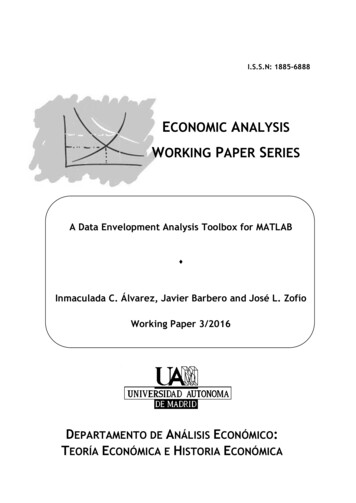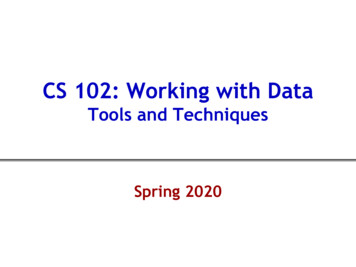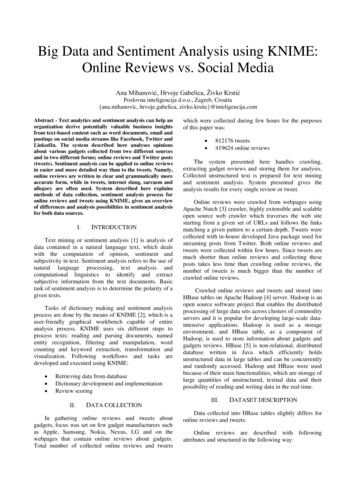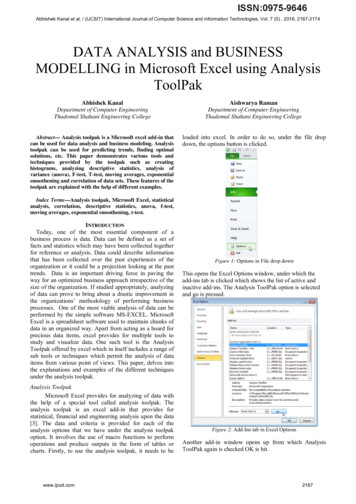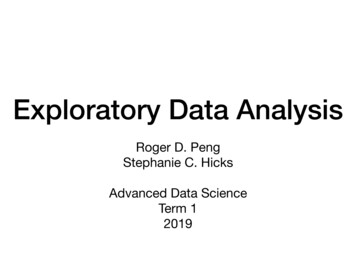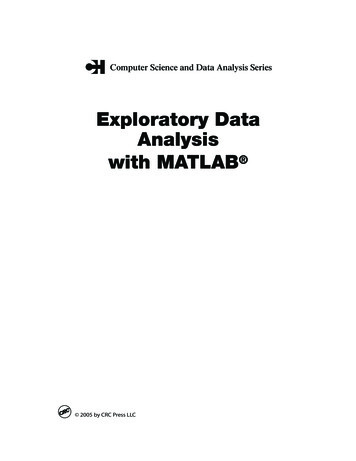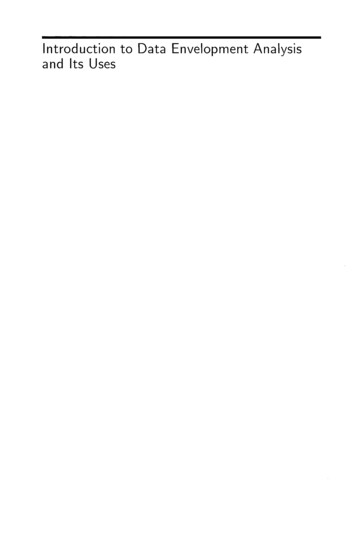
Transcription
Introduction to Data Envelopment Analysisand Its Uses
INTRODUCTION TO DATA ENVELOPMENTANALYSIS AND ITS USESWith DEA-Solver Software and ReferencesWILLIAM W. COOPERUniversity of Texas at Austin, U.S.A.LAWRENCE M. SEIFORDUniversity of Michigan, U.S.A.KAORU TONENational Graduate Institute for Policy Studies, Japan Spriinger
William W. CooperUniversity of Texas, USALawrence M. SeifordUniversity of Michigan, USAKaoru ToneNational Graduate Institute for Policy Studies, JapanLibrary of Congress Cataloging-in-Publication DataISBN-10: 0-387-28580-6 (SC)ISBN-10: 0-387-29122-9 (e-book)ISBN-13: 978-0387-28580-1 (SQISBN-13: 978-0387-29122-2 (e-book) 2006 by Springer Science Business Media, Inc.All rights reserved. This work may not be translated or copied in whole or inpart without the written permission of the publisher (Springer Science Business Media, Inc., 233 Spring Street, New York, NY 10013, USA), exceptfor brief excerpts in cormection with reviews or scholarly analysis. Use inconnection with any form of information storage and retrieval, electronicadaptation, computer software, or by similar or dissimilar methodology nowknow or hereafter developed is forbidden.The use in this publication of trade names, trademarks, service marks andsimilar terms, even if the are not identified as such, is not to be taken as anexpression of opinion as to whether or not they are subject to proprietary rights.Printed in the United States of America.9 8 7 6 5 4 3 2 1springeronline.comPrinted on acid-free paper.SPIN 11542650
ToR u t h , Bev and Michiko
ContentsList of TablesxliiList of FiguresxviiPrefacexix1. GENERAL DISCUSSION2.11.1Introduction11.2Single Input and Single Output21.3Two Inputs and One Output Case61.4One Input and Two Outputs Case81.5Fixed and Variable Weights1.6Summary and Conclusion131.7Problem Supplement for Chapter 115BASIC CCR MODEL12212.1Introduction212.2Data222.3The CCR Model232.4From a Fractional to a Linear Program232.5Meaning of Optimal Weights252.6Explanatory Examples2.6.1 Example 2.1 (1 Input and 1 Output Case)25262.6.227Example 2.2 (2 Inputs and 1 Output Case)2.7Illustration of Example 2.2302.8Summary of Chapter 2322.9Selected Bibliography332.10 Problem Supplement for Chapter 23. CCR MODEL AND PRODUCTION CORRESPONDENCE34413.1Introduction413.2Production Possibility Set423.3The CCR Model and Dual Problem433.4The Reference Set and Improvement in Efficiency47vii
iINTRODUCTION TO DATA ENVELOPMENT ANALYSIS AND ITS USES3.5Theorems on CCR-Efficiency483.6Computational Aspects of the CCR Model3.6.1 Computational Procedure for the CCR Model3.6.2 Data Envelopment Analysis and the Data3.6.3 Determination of Weights ( Multipliers)3.6.4 Reasons for Solving the CCR Model Using the Envelopment Form50505252523.7Example533.8The Output-Oriented Model583.9Discretionary and Non-Discretionary Inputs603.10 Summary of Chapter 3643.11 Notes and Selected Bibliography653.12 Related DEA-Solver Models for Chapter 3673.13 Problem Supplement for Chapter 368ALTERNATIVE DEA MODELS834.1Introduction834.2The BCC Models4.2.1 The BCC Model4.2.2 The Output-oriented BCC Model8587894.3The Additive Model4.3.1 The Basic Additive Model4.3.2 Translation Invariance of the Additive Model9090934.4A Slacks-Based Measure of Efficiency (SBM)954.4.1 Definition of SBM964.4.2 Interpretation of SBM as a Product of Input and Output Inefficiencies 974.4.3 Solving SBM974.4.4 SBM and the CCR Measure994.4.5 The Dual Program of the SBM Model1004.4.6 Oriented SBM Models1014.4.7 A Weighted SBM Model1014.4.8 Numerical Example (SBM)1024.5Russell Measure Models1024.6Summary of the Basic DEA Models1044.7Summary of Chapter 41064.8Notes and Selected Bibliography1074.9Appendix: Free Disposal Hull (FDH) Models1074.10 Related DEA-Solver Models for Chapter 41094.11 Problem Supplement for Chapter 4110RETURNS TO SCALE1195.1Introduction1195.2Geometric Portrayals in DEA1225.3BCC Returns to Scale1245.4CCR Returns to Scale1265.5Most Productive Scale Size1315.6Further Considerations135
Contentsix5.7Relaxation of the Convexity Condition1385.8Decomposition of Technical Efficiency5.8.1 Scale Efficiency5.8.2 Mix Efficiency5.8.3An Example of Decomposition of Technical Efficiency1401401421435.9An Example of Returns to Scale Using a Bank Merger Simulation5.9.1 Background5.9.2 Efficiencies and Returns to Scale5.9.3 The Effects of a Merger1441441441475.10 Summary1505.11 Additive Models1505.12 Multiplicative Models and "Exact" Elasticity1535.13 Summary of Chapter 51585.14 Appendix: FGL Treatment and Extensions1595.15 Related DEA-Solver Models for Chapter 51605.16 Problem Supplement for Chapter 5161MODELS WITH RESTRICTED MULTIPLIERS1656.1Introduction1656.2Assurance Region Method6.2.1 Formula for the Assurance Region Method6.2.2 General Hospital Example6.2.3 Change of Efficient Frontier by Assurance Region Method6.2.4 On Determining the Lower and Upper Bounds1661661691711726.3Another Assurance Region Model1736.4Cone-Ratio Method6.4.1 Polyhedral Convex Cone as an Admissible Region of Weights6.4.2 Formula for Cone-Ratio Method6.4.3 A Cone-Ratio Example6.4.4 How to Choose Admissible Directions1741741751761776.5An Application of the Cone-Ratio Model1776.6Negative Slack Values and Their Uses1826.7A Site Evaluation Study for Relocating Japanese Government Agencies outof Tokyo6.7.1 Background6.7.2 The Main Criteria and their Hierarchy Structure6.7.3 Scores of the 10 Sites with respect to the 18 Criteria6.7.4 Weights of the 18 Criteria by the 18 Council Members (Evaluators)6.7.5 Decision Analyses using Averages and Medians6.7.6 Decision Analyses using the Assurance Region Model6.7.7 Evaluation of "Positive" of Each Site6.7.8 Evaluation of "Negative" of Each Site6.7.9 Uses of "Positive" and "Negative" Scores6.7.10 Decision by the Council6.7.11 Concluding ary of Chapter 61936.9Notes and Selected Bibliography194
XINTRODUCTION TO DATA ENVELOPMENT ANALYSIS AND ITS USES6.10 Related DEA-Solver Models for Chapter 61946.11 Problem Supplement for Chapter 61957. NON-DISCRETIONARY AND CATEGORICAL -controllable, Non-discretionary and Bounded Variable Models7.3.1 Non-controllable Variable (NCN) Model7.3.2 An Example of a Non-Controllable Variable7.3.3 Non-discretionary Variable (NDSC) Model7.3.4 Bounded Variable (BND) Model7.3.5 An Example of the Bounded Variable Model2072072082102122127.4DEA with Categorical DMUs7.4.1 An Example of a Hierarchical Category7.4.2 Solution to the Categorical Model7.4.3 Extension of the Categorical Model2152152162177.5Comparisons of Efficiency between Different Systems7.5.1 Formulation7.5.2 Computation of Efficiency7.5.3 Illustration of a One Input and Two Output Scenario2192192202207.6Rank-Sum Statistics and DEA7.6.1 Rank-Sum-Test (Wilcoxon-Mann-Whitney)7.6.2 Use of the Test for Comparing the DEA Scores of Two Groups7.6.3 Use of the Test for Comparing the Efficient Frontiers of Two Groups7.6.4 Bilateral Comparisons Using DEA7.6.5 An Example of Bilateral Comparisons in DEA7.6.6 Evaluating Efficiencies of Different Organization Forms2212222232242242252267.7Summary of Chapter 72287.8Notes and Selected Bibliography2287.9Related DEA-Solver Models for Chapter 72287.10 Problem Supplement for Chapter 78. ALLOCATION 8.2.38.2.42462462482482498.3New Cost Efficiency under Different Unit Prices8.3.1 A New Scheme for Evaluating Cost Efficiency8.3.2 Differences Between the Two Models8.3.3 An Empirical Example8.3.4 Extensions2502502522532558.4Decomposition of Cost Efficiency8.4.1 Loss due to Technical Inefficiency8.4.2 Loss due to Input Price Inefficiency257257258Efficiency with Common Prices and CostsCost EfficiencyRevenue EfficiencyProfit EfficiencyAn Example
Contents8.4.38.4.48.4.5Loss due to Allocative InefficiencyDecomposition of the Actual CostAn Example of Decomposition of Actual Costxi2592592608.5Summary of Chapter 88.6Notes and Selected Bibliography2618.7Related DEA-Solver Models for Chapter 82628.8Problem Supplement for Chapter 82649. DATA VARIATIONS2602719.1Introduction2719.2Sensitivity Analysis9.2.1 Degrees of Freedom9.2.2 Algorithmic Approaches9.2.3 Metric Approaches9.2.4 Multiplier Model Approaches2712712722722759.3Statistical Approaches2799.4Chance-Constrained Programming and Satisficing in DBA9.4.1 Introduction9.4.2 Satisficing in DBA9.4.3 Deterministic Equivalents9.4.4 Stochastic Efficiency2862862862872909.5Window Analysis9.5.1 An Example9.5.2 Application9.5.3 Analysis2922922932959.6Summary of Chapter 92969.7Related DEA-Solver Models for Chapter 929710. SUPER-EFFICIENCY MODELS30110.1 Introduction30110.2 Radial Super-efficiency Models30210.3 Non-radial Super-efficiency Models10.3.1 Definition of Non-radial Super-efficiency Measure10.3.2 Solving Super-efficiency10.3.3 Input/Output-Oriented Super-efficiency10.3.4 An Example of Non-radial Super-efficiency30530630730830810.4 Extensions to Variable Returns-to-Scale10.4.1 Radial Super-efficiency Case10.4.2 Non-radial Super-efficiency Case30930931010.5 Summary of Chapter 1031110.6 Notes and Selected Bibliography31110.7 Related DEA-Solver Models for Chapter 1031110.8 Problem Supplement for Chapter 10312AppendicesA-Linear Programming and Duality315
xiiINTRODUCTION TO DATA ENVELOPMENT ANALYSIS AND ITS USESA.lLinear Programming and Optimal Solutions315A.2Basis and Basic Solutions315A.3Optimal Basic Solutions316A.4Dual Problem317A.5Symmetric Dual Problems318A.6Complementarity Theorem319A.7Farkas' Lemma and Theorem of the Alternative320A.8Strong Theorem of Complementarity321A.9Linear Programming and Duality in General Form323B-Introduction to DEA-Solver326B.lPlatform326B.2Installation of DEA-Solver326B.3Notation of DBA Models326B.4Included DBA Models327B.5Preparation of the Data FileB.5.1 The CCR, BCC, IRS, DRS, GRS, SBM, Super-Efficiency and FDHModelsB.5.2 The AR ModelB.5.3 The ARC ModelB.5.4 The NCN and NDSC ModelsB.5.5 The BND ModelB.5.6 The CAT, SYS and Bilateral ModelsB.5.7 The Cost and New-Cost ModelsB.5.8 The Revenue and New-Revenue ModelsB.5.9 The Profit, New-Profit and Ratio ModelsB.5.10 The Window ModelsB.5.11 Weighted SBM Model327B.6Starting DBA-Solver336B.7Results336B.8Data LimitationsB.8.1 Problem Size340340B.8.2340B.9Sample Problems and ResultsInappropriate Data for Each ModelB.IO Summary of Headings to 342C-Bibliography343Author Index345Topic Index347
List of ingle Input and Single Output CaseEfficiencyTwo Inputs and One Output CaseOne Input and Two Outputs CaseHospital CaseComparisons of Fixed vs. Variable WeightsOptimal Weights for Hospitals A and BExample 2.1Results of Example 2.1Example 2.2Results of Example 2.2Primal and Dual CorrespondencesExample 3.1Results of Example 3.1State-mandated Excellence Standards on Student OutcomesNon-Discretionary InputsWorksheets Containing Main ResultsData and Scores of 5 StoresOptimal Weights and SlacksCCR-projection in Input and Output OrientationsPrimal and Dual Correspondences in BCC ModelData and Results of Example 4.1Data and Results of CCR and SBMSummary of Model CharacteristicsDecomposition of Technical EfficiencyData of 11 Regional and 9 City Banks*Efficiencies and Returns to ScaleWeights, Slacks and ProjectionsEfficiency of Projected and Merged BanksResults of Input-oriented/Output-oriented BCC CasesData for 14 02105143145146148148163169xm
xivINTRODUCTION TO DATA ENVELOPMENT ANALYSIS AND ITS .79.810.110.210.3Efficiency and Weight of 14 Hospitals by CCR ModelEfficiency and Weight of 14 Hospitals with Assurance RegionMethodEfficiency of 14 Hospitals by CR (Cone-Ratio) and CCR ModelsNumber of Bank Failures (through 10-31-88)Inputs and OutputsCCR and Cone-Ratio Efficiency Scores (1984, 1985)*Printout for Cone-Ratio CCR Model - Interstate Bank of FortWorth, 1985.Scores (Sij) of 10 Sites (A-J) with respect to 18 Criteria (ClC18)Statistics of Weights assigned the 18 Criteria (C1-C18) by 18Council MembersAverages and Medians of Scores of the 10 SitesData for Public Libraries in TokyoEfficiency of Libraries by CCR and NCNData of 12 Japanese Baseball Teams in 1993Projection of Attendance by CCR and Bounded ModelsCategorization of LibrariesNine DMUs with Three Category LevelsComparisons of Stores in Two SystemsComparisons of Two SystemsExample of Bilateral ComparisonsSample Data for Allocative EfficiencyEfficienciesComparison of Traditional and New SchemeData for 12 HospitalsNew Data Set and EfficienciesDecomposition of Actual CostData for a Sensitivity AnalysisInitial SolutionsResults of 5% Data VariationsOLS Regression Estimates without Dummy VariablesStochastic Frontier Regression Estimates without Dummy VariablesOLS Regression Estimates without Dummy Variables on DEAefficient DMUsStochastic Frontier Regression Estimates without Dummy Variables on DEA-efficient DMUsWindow Analysis: 56 DMUs in U.S. Army Recruitment Battalions 3 Outputs - 10 InputsTest DataAndersen-Petersen Ranking*Non-radial 282283284285294303304309
LIST OF TABLES10.410.510.6A.lA.2B.lB.2Data for Super-efficiencySuper-efficiency Scores under Variable RTSSuper-efficiency Scores under Constant RTSSymmetric Primal-Dual ProblemGeneral Form of Duality RelationWindow Analysis by Three Adjacent YearsHeadings to Inputs/OutputsXV312313313319324339342
List of isons of Branch StoresRegression Line vs. Frontier LineImprovement of Store ATwo Inputs and One Output CaseImprovement of Store ylOne Input and Two Outputs CaseImprovementExcel File "HospitalAB.xls"Example 2.1Example 2.2Region PThe Case of DMU AA Scatter Plot and Regression of DEA and Engineering Efficiency RatingsEnvelopment Map for 29 Jet EnginesA Comparative Portrayal and Regression Analysis for 28 Engines (All Data Except for Engine 19)Production Possibility SetExample 3.1Production Frontier of the CCR ModelProduction Frontiers of the BCC ModelThe BCC ModelThe Additive ModelTranslation in the BCC ModelTranslation in the Additive ModelFDH RepresentationTranslation in the CCR ModelReturns to ScaleReturns to Scale: One Output-One InputMost Productive Scale SizeThe IRS Model3457899172730313236373843578484869194, 94107111120122128138xvii
8B.9B.IOB.llB.12B.13B.14INTRODUCTION TO DATA ENVELOPMENT ANALYSIS AND ITS USESThe DRS ModelThe GRS ModelScale EfficiencyMerger is Not Necessarily Efficient.Efficiency Scores with and without Assurance Region ConstraintsAssurance RegionConvex Cone generated by Two VectorsThe Hierarchical Structure for the Capital Relocation ProblemPositives and Negatives of the 10 SitesOne Input Exogenously Fixed, or Non-DiscretionaryDMUs with Controllable Category LevelsComparisons between Stores using Two SystemsBilateral Comparisons-Case 1Bilateral Comparisons-Case 2Case 1Case 2Controllable Input and OutputCategorization (1)Categorization (2)Technical, Allocative and Overall EfficiencyDecomposition of Actual CostStable and Unstable DMUsA Radius of StabilityThe Unit Isoquant Spanned by the Test Data in Table 10.1Sample.xls in Excel SheetSample-AR.xls in Excel SheetSample-ARG.xls in Excel SheetSample-NCN (NDSC).xls in Excel SheetSample-BND.xls in Excel SheetSample-CAT.xls in Excel SheetSample-Cost (New-Cost) .xls in Excel SheetSample-Revenue(New-Revenue).xls in Excel SheetSample-Window.xls in Excel SheetSample-Weighted SBM.xls in Excel SheetA Sample Score SheetA Sample Graph2Variations through WindowVariations by 335336337338339340
Preface1. IntroductionWe earlier coauthored a text, published in 2000, that is described in the following "Preface to Data Envelopment Analysis: A Comprehensive Text withModels, Applications, References and DEA Solver Software." The present textmodifies and revises that book in order to incorporate important new developments. These developments have appeared in papers, books, monographs, etc.,that now number in the thousands and address a wide range of different problems by many different authors in many different countries. See the publicationsthat appear in the disk that accompanies this text. See also Tavares (2003) "ABibliography of Data Envelopment Analysis (1978-2001)" which hsts more than3200 papers, books, monographs, etc. addressing a great variety of problemsby more than 1600 authors in 42 countries.To accommodate all of these developments is now nearly impossible. Wehave therefore directed our attention to an "introduction" — hence the titleof this book. This means that we have focused on approaches that have beenmost widely used or are most likely to be encountered by users of DEA and wehope to include others in a follow-on book.2. What is Data Envelopment Analysis?Data Envelopment Analysis (DEA) was accorded this name because of theway it "envelops" observations in order to identify a "frontier" that is usedto evaluate observations representing the performances of all of the entitiesthat are to be evaluated. Uses of DEA have involved a wide range of differentkinds of entities that include not only business firms but also government andnon-profit agencies including schools, hospitals, military units, police forcesand court and criminal justice systems as well as countries, regions, etc. Theterm "Decision Making Unit" (DMU) was therefore introduced to cover, in aflexible manner, any such entity, with each such entity to be evaluated as partof a collection that utilizes similar inputs to produce similar outputs. Theseevaluations result in a performance score that ranges between zero and unity
XXINTRODUCTION TO DATA ENVELOPMENT ANALYSIS AND ITS USESand represents the "degree of efficiency" obtained by the thus evaluated entity.In arriving at these scores, DEA also identifies the sources and amounts ofinefficiency in each input and output for every DMU. It also identifies theDMUs (located on the "efficiency frontier") that entered actively in arriving atthese results. These evaluating entities are all efficient DMUs and hence canserve as benchmarks en route to effecting improvements in future performancesof the thus evaluated DMUs.The different types of efficiency covered in this text range from "allocative,"or "price," efficiency, and extend through "scale" and "technical" efficiency,as well as "mix" and other kinds of efficiencies. Technical inefficiency, whichrepresents "waste," is the one we focus on in this Preface because it requires theleast information, makes the fewest assumptions, and is the one most likely tobe agreed upon as to what is meant by the term "inefficiency." Uses of DEA toeffect these evaluations are almost entirely "data dependent" and do not requireexplicit characterizations of relations like "linearity," "nonlinearity," etc., whichare customarily used in statistical regressions and related approaches wherethey are assumed to connect inputs to outputs, etc.3. Engineering-Science Definitions of EfficiencyTo illustrate these uses we start with the usual "output-to-input ratio" definitions (and measures) of efficiency used in engineering and science. Consider,for instance, the following definition (quoted from the Encyclopedia Americana(1966) ) where it is illustrated by an example from the field of combustionengineering: "Efficiency is the ratio of the amount of heat liberated in a givendevice to the maximum amount which could be liberated by the fuel [beingused]." In symbols, E Vr/yRj where yji Maximum heat that can be obtained from a given input of fuel and yr Heat obtained from this same fuelinput by the device being rated.In "pure science" the rating would probably be obtained from theoreticalconsiderations, such as are available from the theory of thermodynamics, toobtain a value 0 E 1, with a value of unity not being obtainable. Inapplied science or engineering, alternative approaches are likely be used. Forinstance, the rating of a furnace that is being developed for sale would beevaluated by comparing it with a "reference furnace" with a value of unitybeing obtained when the heat obtained is equal to the heat from the referenceunit.Other approaches are used when ratings for n( 1) devices are to be developed in order to determine relative efficiencies. See Buha et al (2000) foran example involving relative evaluations of 29 jet aircraft engines in whichDEA is compared with the customarily employed engineering measure of efficiency. This engineering measure of efficiency consists of the ratio of "workrate output" to "fuel energy input." Using this same input and output, DEAproduced the same efficiency rankings as the engineering measure. However,other factors (including cost) also need to be considered en route to a decisionon which engine to choose. To accommodate these other measures, DEA was
PREFACEXXIexpanded to three inputs and two outputs and produced rankings that weremarkedly different from the engineering measure.To accompHsh this kind of result, DEA expands the ratio definition of efficiency to accommodate multiple outputs and multiple inputs. This expansion to multiple inputs and outputs is accomplished without using preassignedweights or other devices such as are commonly employed in index number (orlike) constructions and no a priori identification of reference units, etc., arerequired. Proceeding in this manner DEA identifies a set of "best performers"from a collection of DMUs and uses them to generate "efficiency scores" obtained by evaluating each of the n DMUs. This is accomplished by identifyinga point on this frontier that assigns a value of 0 1 to each of the nDMUs. This score is obtained by comparing the performance of the DMU tobe evaluated relative to the performances of all DMUs.As obtained by DEA, this score reflects a series of weights as determinedfrom the data by DEA — one for each output and one for each input - thatproduces the highest efficiency score that the data will allow relative to thevalues 0 Ej 1 for each of the several DMUj j 1 , . . . , n, being considered.Moreover, these weights (called "multipliers" to distinguish them from customary weighting processes) have additional uses. A multiplier can be used, forinstance, to evaluate changes in the efficiency score for a DMU that will accompany a change in the corresponding input or output. Since these multipliers areapplicable to all DMUs, they can also be used to conduct "sensitivity analyses"to determine changes in all data (considered simultaneously) that will resultin a change of classification from "efficient" to "inefficient," or vice versa forany DMU, and also identify the ranges of data variation that can be allowedbefore such a change occurs. Unlike statistical and mathematical programminganalyses, in which sensitivity analyses apply to only one data point at a time,these sensitivity analysis can allow simultaneous variation in all of the data.How this is done is described in this book. Also described in this book aremethods for undertaking a one-data-point-at-a-time analysis (as in statistics,say) that can also be used to determine the allowable range of stability for thedata changes associated with any individual DMU.4. Different Definitions of Efficiency—and DualityThe above discussion is based on generalizations (and additional uses) of engineering-science definitions of efficiency. There are, however, other definitions ofefficiency that are used in other disciplines. One such is the very general definition of efficiency, called "Pareto optimaHty," as used in "welfare economics,"which was formulated by the Swiss-Italian economist, Vilfredo-Pareto. Thedefinition, as given on page 319 in Pearce (1986)" is as follows: "A Pareto optimum is a welfare maximum defined as a position [in an economy] from whichit is impossible to improve anyone's welfare by altering production or exchangewithout impairing someone else's welfare." This definition forms a basis for"welfare economics" in which proposed changes in policy (e.g., enactment of atariff) are to be judged according to whether the proposed change can increase
xxiiINTRODUCTION TO DATA ENVELOPMENT ANALYSIS AND ITS USESthe welfare of some without worsening the welfare of others. This approach,we might note, avoids the need for making interpersonal comparisons such aswould take the form of weights, or similar devices, that assign relative valuesto different individuals in making such decisions.Tjalling Koopmans (1951), a Dutch-American economist, subsequentlyextended this definition to "production economics" by introducing "efficiencyprices" ( multipliers) to guide production and exchange to positions that aresimilar to a Pareto optimum. This approach is further extended and exploitedin DEA by reference to what is referred to as the "Pareto-Koopmans" definitionof eflSciency.As shown in the present book, these seemingly different definitions involvedin engineering-science and Pareto-Koopmans definitions of efficiency are mathematically related to each other by the "duality theorem" of linear programming.See Appendix A in this book for a description and discussion of duality andother parts of linear programming. To state this differently, there is a problemthat is dual to the one used to implement the engineering definition of efficiencywhich employs the same data in a different manner to arrive at a measure ofPareto-Koopmans efficiency. At their corresponding minimum and maximumvalues the Pareto-Koopmans and engineering science scores are then equal.This dual problem utilizes the following variant of a "welfare optimum" indefining efficiency:Definition 1 (Pareto-Koopmans Definition of Efficiency) The performance ofa DMU is efficient if and only if it is not possible to improve any input or outputwithout worsening any other input or output.From this we also haveDefinition 2 {Definition of Inefficiency) The performance of a DMU is inefficient if and only if it is possible to improve some input or output withoutworsening some other input and output.Thus a characterization of being inefficient holds if and only if the observation— i.e., the input-output coordinates — for the DMU being evaluated is not onthe efficiency frontier of the set of production possibilities that can be generatedby DEA from the data on all observations. Conversely, the geometric pointsassociated with the performance of the DMU to be evaluated by DEA will befound to be efficient if and only if it is on the efficiency frontier.5. Extensions and Further Uses of DEAThe above generalization of the engineering-science definition of efficiency involves maximizing a ratio of inputs to outputs subject to a collection of nratios that also take the form of inequality constraints with a bound of unityon their possible values. However, as shown in this book, this nonlinear (andnon-convex) problem can be replaced by a simple (ordinary) linear programming problem that makes the solution easily obtainable from any of numerouscomputer codes that are used to solve linear programming problems. It also
PREFACEXXlllopens other possibilities for use from now available computer codes that arespecifically designed for use in DEA. See, for instance, the DEA-Solver codethat is described in Appendix B of this book.Using the duality relation of linear programming to comprehend these twodifferent definitions of efficiency and giving them implementable form greatlyextends the ability of DEA to deal with a wide range of problems. For instance,the study recommending a relocation of the Japanese capital to a new site (nowbeing considered by the Japanese Diet) had to deal with "inputs" like "susceptibility to earthquakes" and with "outputs" like "ability to recover from earthquakes." These are not "inputs" or "outputs" in the ordinary senses of theseterms and are therefore referred to as "goods" or "bads" according to whetherthey should be placed in the numerator or denominator of an engineeringscience type of "efficiency ratio" in accordance with whether an increase in thisitem should result in an increase or a decrease in the performance score. Thisgreatly simplifies matters that would otherwise be difficult to accomplish enroute to identifying inputs as distinguished from outputs (in borderline cases)that could be difficult to do with the Pareto-Koopmans definition of efficiency.This illustrates one way that the "conceptual power" of the engineering-sciencedefinition of efficiency can be used to obtain characterizations that also satisfythe Pareto-Koopmans definition. The thus identified inputs and outputs thathad to be considered in the Japan relocation study were then incorporated ina DEA model that was directed to "effectiveness" rather than "efficiency" inorder to determine the best location (two "equally best" locations were identified). As defined in this book, these two concepts differ as follows:Effectiveness- I ' ' " ' '( Ability to achieve goals.goaBenefits securedEfficiency:Resources used.Thus effectiveness refers to goal achievement and, in contrast to efficiency,effects its evaluations without reference to the resources used. (See Chapter 6 inthis book for further discussion of how the committee appointed to conduct thisstudy developed its reports to produce recommendations that were submittedto the Prime Minister who has transmitted them to the Japanese Diet forconsideration).These and the other developments in the use of DEA are all given implementable f
X INTRODUCTION TO DATA ENVELOPMENT ANALYSIS AND ITS USES 6.10 Related DEA-Solver Models for Chapter 6 194 6.11 Problem Supplement for Chapter 6 195 7. NON-DISCRETIONARY AND CATEGORICAL VARIABLES 203 7.1 Introduction 203 7.2 Examples 205 7.3 Non-contro
